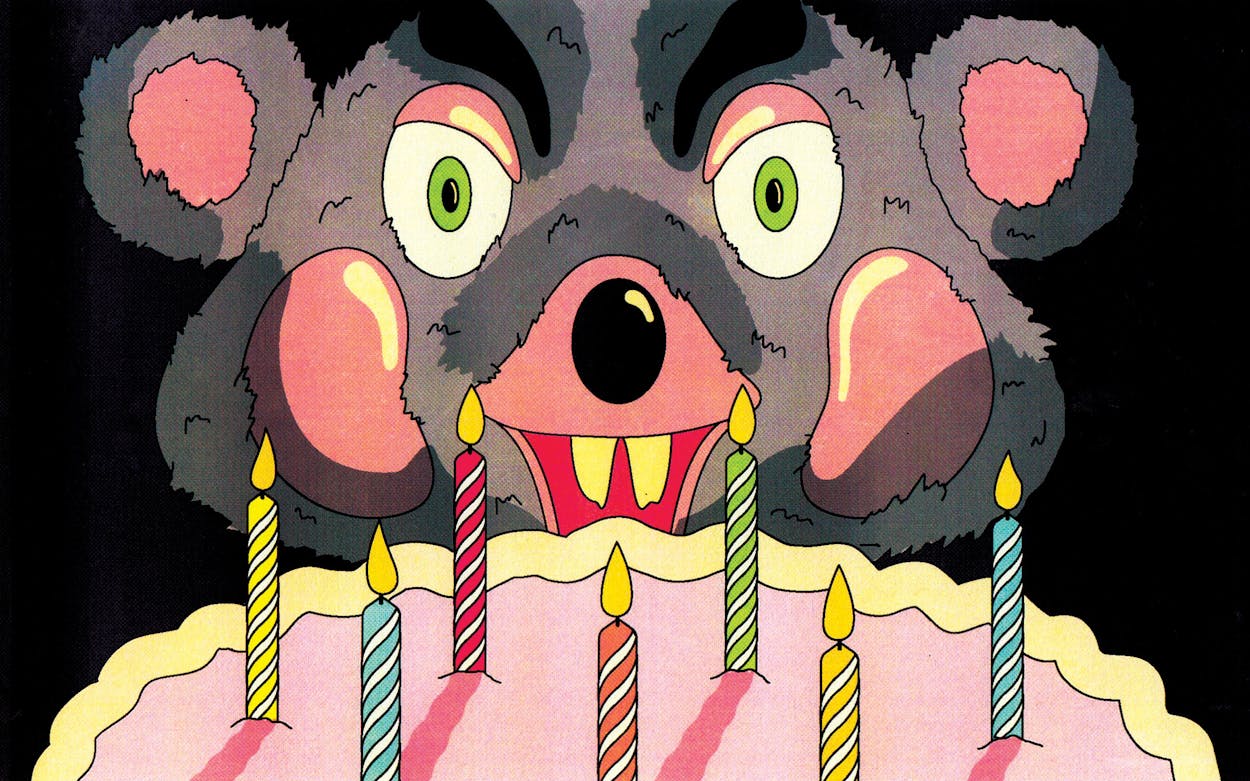A few years ago, I got some of my family’s videotapes converted to digital files. One of the bits of resurrected footage was of my little sister’s third birthday party, at a Chuck E. Cheese on Austin’s Louis Henna Boulevard. She looked sweet, with her shy grin and halo of short curls, but a little oblivious to the chaos surrounding her. I held court, dancing around the table, urging my sister to blow out her candles, and cohosting. At nine years old, I was already an expert at the Chuck E. Cheese birthday party, a rite of passage for any child of the nineties in America.
Being at Chuck E. Cheese, whether for my birthday or someone else’s, is a core memory of my youth. Of course, I remember the pizza, soda, and cake that would accompany every celebration; using the bronze tokens in my sweaty palm to play Skee-Ball and Whac-A-Mole; and presenting my hard-earned tickets to the cashier in return for stickers, erasers, and a candy necklace. But most of all, I remember the animatronic band, led by the blinking, head-swiveling rat-mouse-god, Charles Entertainment Cheese.
As a child, it was like watching a horror movie through your fingers. The larger-than-life robotic characters—a purple monster, a hen with pigtails, a Southern hound dog, and a maybe-offensive interpretation of an Italian pizza chef—towered over you on a raised stage. They would sputter to life to play some original songs intertwined with comedic dialogue. The mouth movements never matched the recorded vocals, you could hear the clicks and whirrs of the mechanics if you stood close enough to the stage, and the jerky, repetitive blinks and torso twists were an uncanny valley to my little brain. But I loved it all anyway.
Chuck E. Cheese was the brainchild of Nolan Bushnell, who’d also founded the video game company Atari. The animatronic entertainment was Bushnell’s homage to Disneyland’s Country Bear Jamboree. The first Chuck E. Cheese (then going by its longer, clunkier name, Chuck E. Cheese’s Pizza Time Theatre) opened in San Jose, California, in 1977.
In 1979, Kansas businessman Robert Brock became involved, earning franchising rights in the South and Midwest. Brock soon became enamored with the animatronic work of another engineer, Aaron Fechter. Brock and Fechter opened ShowBiz Pizza Place, a near re-creation of Chuck E. Cheese, but with Fechter’s animatronics. A legal battle ensued, and the two companies settled out of court, with ShowBiz—a subsidiary of Brock’s national Brock Hotel Corporation (BHC)—agreeing to pay some of its profits to Chuck E. Cheese.
A few years later, in 1984, Chuck E. Cheese filed for Chapter 11 bankruptcy, and Brock came to the rescue to buy his rival and merge it with ShowBiz Pizza under the BHC umbrella. BHC had moved from Topeka, Kansas, to Irving in 1982 so it could be close to the travel hub of the Dallas–Fort Worth airport. Thus, when Chuck E. Cheese joined BHC in 1985, it became a Texas-based company.
If this sounds like a lot of drama for an entertainment center for children, please know that I left out many details for the sake of brevity, as well as the subsequent mergers and acquisitions and rebrands.
Chuck E. Cheese didn’t just make a strong impression on this millennial. The internet is littered with the lore of the brand, from fan websites to lengthy YouTube explainers to videos of people walking through abandoned locations.
Although the brand has limped along, the COVID-19 pandemic proved damaging, and many locations had to permanently close. But the Cheese is not dead yet! In fact, the company got creative during the pandemic by offering pizza on food delivery apps under a different name. Shockingly, the brand is continuing to expand outside the U.S., with locations coming soon to Jamaica and Guyana. Congrats to the children of the Caribbean!
The biggest blow (personally) was the news in 2017 that Chuck E. Cheese would be slowly phasing out all animatronics in favor of dance floors. It is my personal belief that all children have the right to get the bejesus scared out of them by ten-foot-tall robots. It builds character.
While Chuck E. Cheese’s glory days may be long gone, I still wanted to check one out in 2023 to see if it matched up with my memories. I invited my friend and her four-year-old along for a couple hours of fun. The location we went to in South Austin seemed surprisingly clean (not to besmirch the reputation of this establishment, but I recall a dingier vibe as a child). The stage featured an animatronic Chuck E. that moved from side to side but didn’t do much of anything else. We ordered a large cheese pizza, three sodas, and ninety minutes of play time on a tap card (buh-bye, tokens). My friend’s kid immediately ran out into the arcade to play. She wasn’t terrified when an adult dressed in a Chuck E. costume came out to greet a birthday party. He was “cool,” she said. (Chuck E. has more of a skater-boy getup these days.)
I was worried a sophisticated child of today, who has grown up with iPhones and iPads and Frozen, would be bored by the retro arcade–pizza parlor. Not so. We had a blast trying out the different games and munching on pizza in between. (Note: there are no longer ball pits or SkyTubes.) Even though I’m not a parent, I totally get the appeal—a place where you can let your kiddo run free but not out of sight.
At the end of our outing, the kid—entertained and full—traded the points on her card for some plastic rings and two lollipops, reminding me that some parts of childhood, no matter how many decades apart, are truly universal.
- More About:
- Irving








